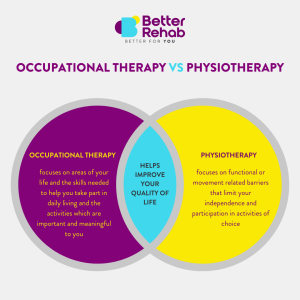You’re not alone if you’re unsure whether to seek support from a Physiotherapist or an Occupational Therapist. Both are allied health disciplines focused on movement and function and their practitioners, Occupational Therapists and Physiotherapists, help adults and children achieve their personal goals.
The word ‘occupation’ in Occupational Therapy is another source of confusion. Rather than meaning job or profession, it refers to the activities or tasks that occupy us and enable us to create a meaningful life. In fact, there is a type of Occupational Therapy designed specifically for children, so the word ‘occupation’ has less relevance to them as they don’t have jobs or a profession!
In this Better Rehab guide, our clinicians explain the differences between these two allied health disciplines and the benefits they can provide to people of all ages.
Occupational Therapy vs Physiotherapy
Occupational Therapy is a form of evidence-based support to help people living with disabilities or health conditions achieve their goals in their daily life. These goals include performing tasks, also called functional tasks, that help them enjoy better, more independent lives, like bathing, preparing meals, using cutlery, moving around the community, and participating in work and recreational activities.
To help you achieve your goals, Occupational Therapists might also consider adapting your environment to allow you to live the way you want to – this might be through assistive technology, or modifications to your home such as the addition of ramps or rails.
Physiotherapy is also a form of evidence-based support and Physiotherapists are considered movement and participation experts, with a core function to promote the health and wellbeing of individuals.
Physios focus on interventions that restore the integrity of body’s systems that are essential to movement, to maximise function and minimise incapacity, and with an overall goal of enhancing quality of life. A participant’s goals with a Physio might include being able to walk to the local shops, play with their children at the beach, breathe better, or garden without pain.

What are the differences and similarities between an Occupational Therapist and a Physiotherapist?
From the definitions above, you can already see the key differences and similarities between these two allied health fields.
The key difference is their focus: an Occupational Therapist focuses on all areas of your life and the skills needed to help you take part in daily living and the activities which are important and meaningful to you while a Physiotherapist focuses on functional or movement related barriers that limit your independence and participation in activities of choice.
The key similarity is their goal: both allied health disciplines share the objective of helping you improve your quality of life. Approached in slightly different ways, a Physiotherapist and an Occupational Therapist can work together to help you address the barriers that limit your participation and independence.
How Nina benefitted from seeing both a Physio and an OT
Nina’s experience may help you understand these two therapies further – and the benefits of having both a Physiotherapist and Occupational Therapist ‘on your team’.
While out walking in her local park, Nina loses her balance and injures her knee. Soon afterwards, she is diagnosed with Multiple Sclerosis (MS), which comes with a range of symptoms that affect her gait and balance.
Should Nina see a Physiotherapist or an Occupational Therapist? The answer is both, and this is why –
A Physiotherapist can help her improve her balance, mobility and functional limitations that impact Nina’s ability to participate in activities of her choice. As a result of Nina’s MS diagnosis, she will need the ongoing support from her Physio to support her mobility needs, reduce her risk of falls and manage her physical fluctuations as they change throughout the course of her disability. Her Physio will be able to recommend and prescribe any Assistive technology that will help Nina maintain her independence. This Assistive technology could include mobility aids, transfer aids or other devices that will support Nina to achieve her goals.
An NDIS Occupational Therapist will assist Nina to maintain independence in her activities of daily life by focusing on skills that help with hygiene, cooking, cleaning and giving her tips to manage her energy levels. Nina’s OT will support Nina by adapting her home environment and prescribing assistive technology to meet her needs.
Both disciplines will work together to support Nina managing her thoughts and feelings around her diagnosis of MS and keep her on track to achieving her goals.
At Better Rehab, we take a multidisciplinary approach, which sees our Physiotherapists and Occupational Therapists regularly collaborating to create comprehensive therapy plans that meet each participant’s needs.
Physiotherapy vs Occupational Therapy – still unsure?
We hope this has been a useful starting point to guide you in making decisions about your or your loved ones’ therapy and support. If you’re still unsure about which therapy is right for you, get in touch by submitting our contact form.
